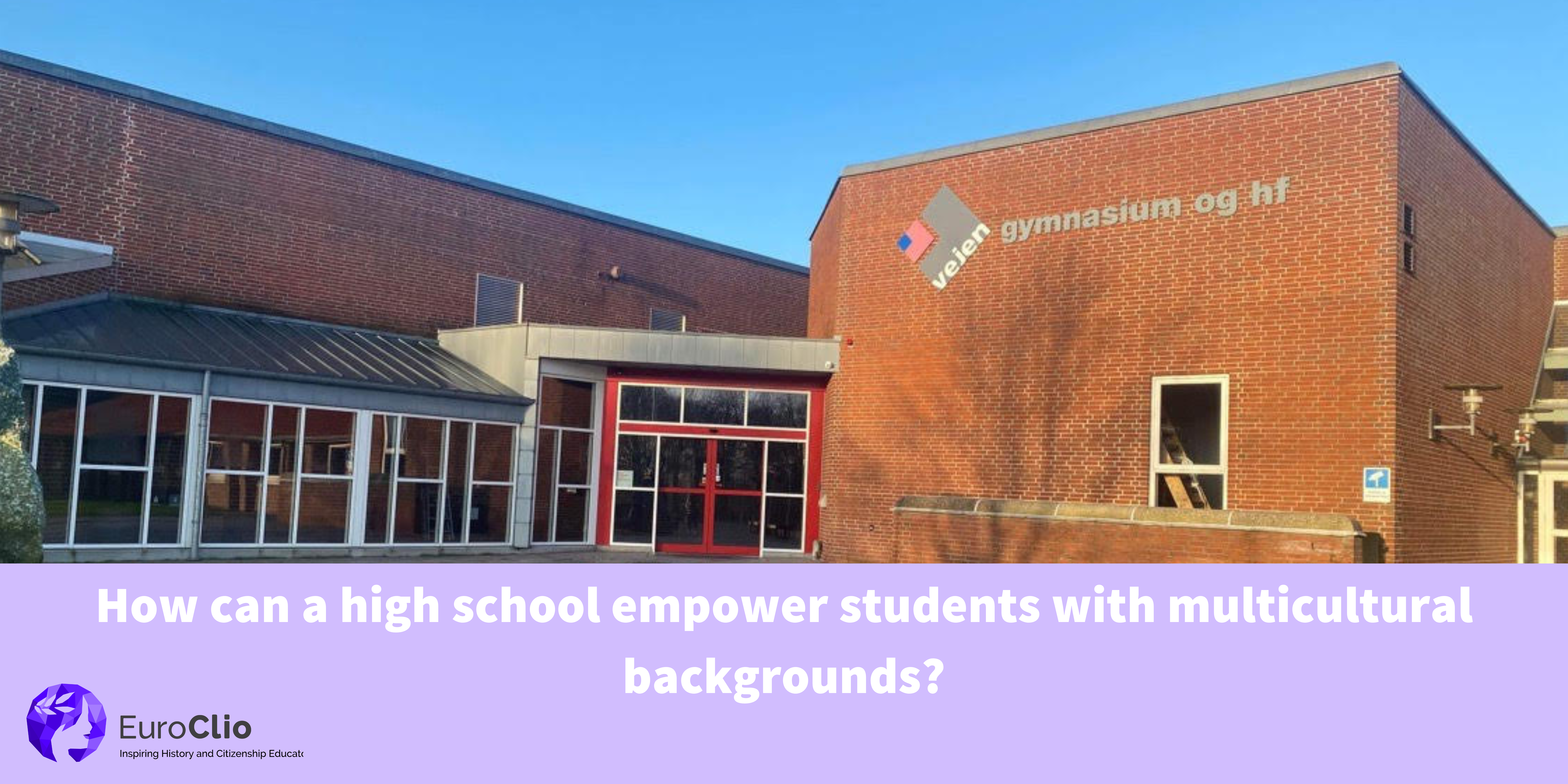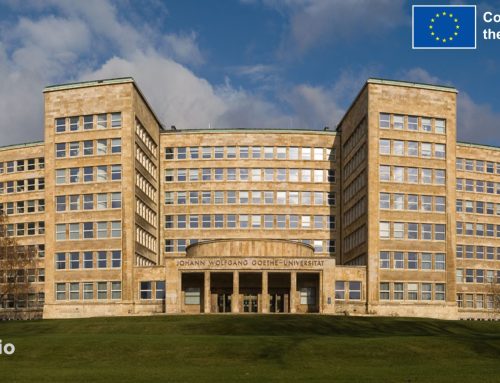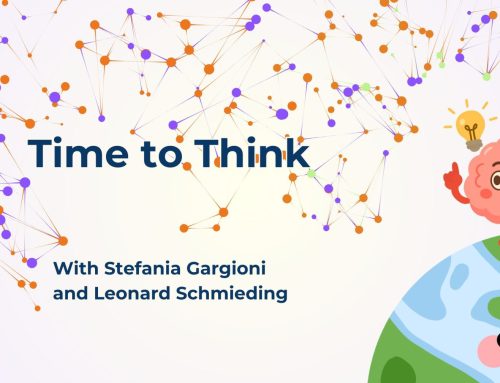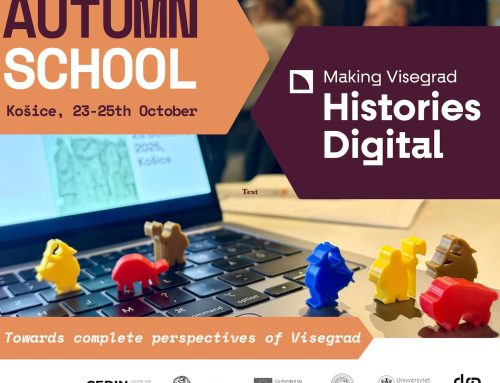Written by Mirela Redzic, teacher at Vejen Upper Secondary School (Denmark)
When I came to Denmark as a 15-year-old in 1994, and two years later started at a Danish upper secondary school, I was overjoyed at the opportunity. Soon after, I realised that the teachers really wanted to help me, but that they didn’t really do so. By help, I mean that I needed extra support to understand the subject matter. Especially Danish and History classes. Over time, I realised that the reason was that they didn’t want to differentiate between students. Of course, this made sense… but I also remember my own awareness of being different. I had gone through two years of the ex-Yugoslavian high school, which was a pretty strong system academically, so I wasn’t afraid of the subjects and of sitting by myself and doing my homework, but many times I didn’t understand what was expected of me. You know all the stuff written ‘between the lines’, the stuff you grow up with in everyday life that no one explains. Some of this was due to language limitations, but some were more cultural limitations. For example, I remember that I simply couldn’t understand words ‘math assignment’. That is, I understood when people explained what it meant, but I couldn’t believe that anyone expected me to go home and do one assignment for a whole week, possibly get lots of help (if you could, because I couldn’t), hand it in and then get my grade… So here, cultural understanding played a significant role, and I kept asking about the meaning of the term ‘assignment’ for a weak, hoping that someone would explain it differently.
“In a study, the Danish Evaluation Institute (EVA) has found that bilingual pupils on average perform worse in primary school than ethnic Danish pupils”, says Michael Wahl Andersen in his book on the importance of strengthening the mother tongue language for academic learning in school and points to the opportunity to work with this. In a project at Vejen Upper Secondary School in the 2017/2018 school year, teacher Mette Vestergaard Krogstrup and the author of this article (with the support of the school’s management) tried to identify how we could work on this issue at our school. The project was linked to the author’s master’s programme, which included a systematic exploration of the situation. This included a programme with approximately 20 students from many different ethnic backgrounds who agreed to participate in the project, as well as the teaching staff’s responses to a questionnaire that attempted to uncover how they had previously worked with these issues in their teaching. The project and its findings might already be outdated, but I can still recognise its results in the new generations of students at the school and I wish to highlight it with this article. The article concentrates mainly on the uncovering of issues that are in the students’ consciousness and that the school and its teachers do not necessarily consider in their everyday work.
I will present some of the project’s results, illustrated with examples from my own teaching experience over the past 17 years. While reading it, it should be kept in mind that the article is based on a small provincial high school in Jutland, which means that our immigrant composition is somewhat different from that of the larger multi-ethnic high schools in big cities. It’s also interesting that there have been more an more students with different ethnic backgrounds in each class for every year since our project took place.
In the article, students with multicultural backgrounds are defined as in my MA thesis project: Multicultural learners are learner who has either arrived in Denmark themselves or has at least one parent that arrived in Denmark from another country.
All students that participated in the project went through an individual interview to begin with. The aim was to uncover common patterns in their relationship to the school and the school’s work. These interviews were later analysed by the author through the ‘didactic triangle’ and the results can be seen in the next section.
The didactic triangle and the student interviews
Due to the complexity of the case, it was natural to analyse the case using a simple model such as the ‘didactic triangle’ (term from Ellen Krogh, Ane Qvortrup & Torben Spanget Christensen, Almendidaktik og fagdidaktik, 2016). The triangle is adapted to the components that the students mentioned as essential in their way of acting in the world and thus also in school (see figure 1). These components are parents, family, and their environment, as well as the school with classmates and teachers. Thus, the matter is more complicated than the school as an organisation and school system. Similarly, parents are not only mum and dad, but in turn also all parents relationships with the outside world of friends and family who can influence the parents/students (and who probably have more influence on parents than in ‘ordinary’ Danish families). Of course, it is difficult to generalise and there are many different families, but my general impression is that this is often the case.
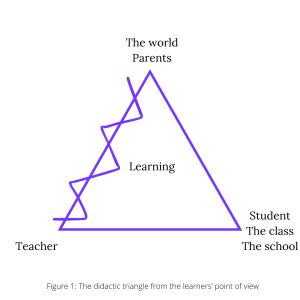
Student interviews in the research phase have shown that students’ parents and the student’s position as the oldest or youngest sibling, their knowledge of the mother tongue language and the family environment play a role in the way students behave in the school. Let’s take a look at this relationship and why it’s so important for students learning possibilities.
Relationships between students and their parents and the parents’ surroundings
The surroundings and situations of the parents may inflict stress upon parents themself, which the parents then consciously or unconsciously pass on to their children (our students) in the form of expectations, which in turn pushes the students in a certain direction. For example, one of the students narrated how she did not drink much, but on the rare occasions when she does drink a beer or two at school parties, she feels the need to tell her parents at home before they hear about it from others. It may seem insignificant, but the fear of ‘gossip’ from other students at school who come from the same culture circle is an additional burden that ethnic Danish children do not have. At the same time, the students are pressured by the native Danish students at the school to drink at parties, as a ‘good party’ for them naturally includes ample influence of alcohol. Thus, there is a pressure of expectation placed upon the students, but this time it is the opposite expectation to the one they might experience with their parents at home – and all while the student need to find out who they are as young individual and what they think about alcohol drinking. The students also said that they responded differently to pressure about alcohol, but overall, they often find themselves in conflict between the expectations of their friends at school and their private world. In the context of this article, I think about the situations where I’ve heard from school staff that alcohol is a normal part of school life or seen images from school social media showing school parties where students are clearly intoxicated – and can’t help but wonder if these images make the students’ decision even harder since the consumption of alcohol is so normalised. So perhaps we – the adults at the school – can work on making it acceptable not to drink alcohol at parties, or by ensuring that there are also gathering possibilities for students where alcohol isn’t or doesn’t have to be present. It may be that this issue has improved since study was done, as indeed the government has asked schools to address the problem but I can still recognize it from our everyday life.
Another example of external pressure that students mentioned during interviews is that their parents are pressurising them to become doctors or engineers. According to the students, this expectation is partly related to the parents’ need to appear as a ‘nice family’ to those around them. Perhaps it is simply easier for parents when their children are working towards an education that they themselves understand and respect. It is easier to explain to those around them what their children are studying and envision their bright future when they understand what they future work. One of the students in the project talked about how she was forced to take on the school’s science programme because her parents wanted her to study medicine, even though she hated math, which is one of the core subjects in this field of study. At the same time, the teachers in this study programme expected the students to be particularly engaged in science subjects and taught according to this expectation. So again, we see a mismatch in expectations for these students, which can easily lead to the student not being very good in their class and experiencing a failure that then translates into yet another burden.
That the connection between parents and students is quite strong can be inferred from the students’ weighting of this question in their individual interviews, but it is probably strongest from the parents’ side. This is because family relationships are quite important in many of the countries where the students have their origins in. In addition, many of these parents came as refugees, bringing with them the experiences of war. War situations can also emphasise the importance of family, especially if you do not have many family members here in Denmark. It was also interesting to realise that we, as teachers, did not know anything about this part of our student families’ history. The big question is whether we should have this knowledge to make differentiated teaching and build the right knowledge of the students’ preconceptions before we start teaching, for example, the French Revolution or human rights.
The fact that students don’t necessarily have uncles, aunts, cousins and grandparents in the country where they grow up is also a fact that makes students more in need of strong relationships with their immediate family or friends. Sometimes we find that they want to connect more with us, their teachers, than we necessarily have the desire or energy to. During the conversations, it also emerged that there are several students who have good friends with Danish origin at school, but they do not meet very often in their free time, which may be due to the students’ attempts to separate the two-way expectations. Or it may also be too strong an experience for the Danish student to visit a foreign family’s home. But whatever the reason is, the fact is that it separates the two worlds the students live in even more sharply and gives the students space to strengthen their relationships with their parents, siblings, and the world around them. This is a great thing in itself, but it also alienates the student even more from their ethnic Danish friends and reinforces the perception that they live in two non-comparable worlds.
The fact is also that many of these parents are not career-seeking and their children are their ‘whole world’. And precisely for this reason, they will do their utmost to ensure their children’s success, leading to an even higher burden of expectations.
There are in other words several mismatched situations that these students are expected to act in. A logical conclusion is that when these and similar situations are constantly repeated during the students’ childhood, it can easily lead to an insecurity in the students’ identity. This happens to quite a few young ethnic Danish teenagers as well, but in our case study the effect is certainly amplified. This was mentioned by several students during our conversations, and it became a key topic of our café-style meetings/workshops led by the school’s coach. This is thus where we can present some advice for schools on where to take action: namely to strengthen the students’ self-confidence, self-esteem and identity formation. It is also obvious that teachers can work with self-awareness and strengthened self-confidence/esteem in their teaching without necessarily differentiating between students.
There is a clear message in Michael Wall Andersen’s before mentioned book, that students who are strong in speaking their mother tongue also find it easier to participate in academic discussions at school. Although Andersen’s study on language focused on maths lessons and primary school, our project at Vejen Upper Secondary School has shown that students who are used to talking about their own culture and history from home find it easier to transfer this to discussions about Danish culture and history at school.
Having looked at the students’ strong relationship with their parents and the private world creates the clash with expectations of classmates in school because their own family relationships are many times not so strong at all. We will now look at the relationship the student has with the school and what this means for students itself.
Student – school relationship
In this context, the school includes subjects, teachers, other students, canteen, management, and so on. The project did not focus on a specific subject, but rather on methods by which the student can improve in the subjects and generally in the school system and later in the labour market. This gave us our analysis and didactic triangle, with the school at one of the corners. So the article will now look at the relationship between student and school, subjects and teachers (see figure 2).
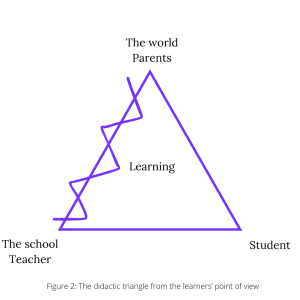
Based on the interviews with the students, we found that the students started upper secondary school with a belief in a fresh start, new possibilities, and that ‘everything will go well’. At the same time, the teachers in the project responded in the questionnaire where they exposed to, an overall desire to treat all students equally. In other words, both parties have good intentions from the start of school, but things often go wrong with these students’ performance, academic development, and grades later on in their student trajectory. Where does the problem arise?
All research shows that student motivation is a crucial factor in learning. But what happens with these students’ motivation when the teacher talks about Danish history or politics, which they often cannot relate to or not seeing it as something good/great? Examples of this could be pride in the Vikings or delight in King Christian IV’s endeavours.
In the questionnaire, teachers say that they try to avoid asking these students questions such as ‘where do you come from originally?’ or ‘how is this perceived in your parents’ culture?’. The reasons for this may be that they do not want to stigmatise students, or that there is simply no time for these conversations and that teachers are unsure about the use of this additional information about individual students. It may also feel like a burden. These are legitimate reasons, but the project has shown that students benefit from having their individual cultural starting points considered. Thus, if we as teachers are not able to talk to the students about themselves from their own point of view, we will effectively make it difficult to give these students the same start for development as the ethnic Danish student. This is also based on the fact that the school, at the time of research, primarily employed ethnically Danish teachers.
By being able to talk to students about their origins, you will naturally spot and understand students who do not necessarily have a different skin colour or a foreign name, but who also have a different ethnic background of some kind. We have increasing numbers of these students at our school. I find it difficult to ask where the students come from, but it is interesting that the times when it becomes a natural thing to talk about in class, it has given me a better understanding of the students. One of my students is half Russian and half English, which gave him a distinct advantage in history class when we discussed the Schisms of the Christian Churches. Often you can turn the lesson around so that the student can, for example, verbalise the differences between the different Christian churches.
Many of the students in the project said in their interviews that they knew a lot about religion because of their upbringing, but that they themselves have abandoned religion in recent years, regardless of which religion they belong to. After several mentioned this, the question arose whether the students consciously or unconsciously try to break with their parents’ religion. And if so, why? It is difficult to prove, but nevertheless, I believe that part of the explanation lies in the fact that they want to be less different from their Danish peers. The Danish ‘Law of Jante’ (denoting a cultural and social attitude of disapproval towards expressions of individuality and personal success) makes it easier to live in Jutland if you are assimilated into Danish society. Thus, by not separating themselves too much, it is easier to strike the balance between their private and public worlds – school and home. In my eyes, this may again be an attempt by the students to meet the different expectations from their two worlds, whereby they live with religion at home in the private sphere where it is expected of them, but not at school where the opposite expectation exists.
An awareness of assimilation is also something that students themselves mentioned during the conversations. For example, several students expressed that they do not say much in class because they are unsure of the language or their knowledge. However, most of them were born and raised in Denmark! Having known them for the last two and a half years, it is impossible to hear that they have problems with the Danish language in everyday life. As their history teacher, I believed it was their subject knowledge that was the cause of this, rather than their Danish language – but nevertheless, several of my students express that this is what they feel. We thus worked with concrete exercises tackling linguistic nuances.
As an experienced teacher, I can safely say that all students are insecure about their academic abilities. But our project showed that these students have an even bigger issue with this insecurity than their ethnic Danish classmates. The question is therefore why this is the case. By talking to the students and analysing these conversations, I concluded that it is partly due to their awareness of their own lack of knowledge of all spheres of Danish everyday life, culture, and history. They realise that they have knowledge gaps in this area, and these gaps make them insecure. In addition, several of the students had previous experiences with other students who said something that made them insecure and which they since carried as a ‘chip on their shoulder’.
Throughout the project, it also became clear that there is a mismatch between the native language culture’s desire for factual knowledge and recognition of authority, as opposed to the students’ school world, where teachers demand critical judgement and academic discussions. In addition, as one of the colleagues – a Danish and history teacher – remarked in his interview, the Danish school system often has an expectation that the student has prior subject knowledge, which is then built on in the more analytical part of the study trajectory. In the interview, the teacher also talked about how she had not wanted to talk directly to one particular student about her problems, as she had been afraid of alienating her. As it turned out, this was exactly what the student needed – which again emphasises a mismatch in the understanding of each other and thus also the expectations of each other, as mentioned earlier in this article. The consequence was that the student had difficulty decoding what teachers or others in the outside world wanted from her because of the mismatch between the expectations of the school and the family. For example, instead of the student asking for help to understand the assignment, she just followed her group, hoping that she would understand it along the way. At the same time, the teacher said in her interview that she saw the student didn’t understood the question and didn’t bother to ask more to understand it so student seemed as not motivated to learn. Again, a clear mismatch in understanding and expectations of each other.
Insecurity also arises between students. They look at their classmates and compare themselves to each other. As an example, one student says: “I don’t have the English accent like others in the class”. The student is all too aware of what other students seem to be able to do easily and feels insecure. The student explains this in his interview: “… Over time, you believe that you cannot do anything. Every time I’ve tried, and it was wrong, it’s just been ‘ummmh… I can’t do this’. So, I’ve given up… and I didn’t dare ask for help”.
The class is in essence just another community that the student wants to assimilate into and the student can become discouraged if they do not from time to time feel validated. This is where the teacher can play a key role by giving the student the belief that they will succeed if they work in a certain way and by having positive expectations of them. We need to do this for all students anyway, so it is in the end not much different, but probably even more effective. However, it is necessary to be even more precise and emphatic in your beliefs and expectations as these students feel a higher degree of insecurity.
Teacher – parent relationship
The last relationship in the didactic triangle is the teacher-parent relationship and it does not involve the student directly. However, it is relevant to look at it as a relationship between the two identity-forming components of the student, where the school belongs to the public and the parents to the private sphere that shapes the student.
This relationship is almost non-existent in most cases at our school level in Denmark. The school and the teacher have little official knowledge about where the student originally comes from, when and why they came to this country, and what issues they may have been that made family to move from their home and home countries.
As mentioned above, according to the teachers’ responses to the questionnaire, all pupils should generally be treated equally, which is why it is perceived as inappropriate to ask pupils about their ancestry – in effect pointing out that they are not like the other pupils. But it also means that teachers do not utilise the individual resources of their students. As a result, the student does not have as many successes during their schooling, and over time, teachers as a result lower their expectations of the student.
On the other hand, parents also have little contact with the school and do not get to know the school system their child is in. When they raise their children, they do so with the knowledge and experiences from the educational system of their home country, which often places a stronger emphasis on respect, obedience, and factual knowledge to be learnt from books. This puts students again in a mismatch position, because of teachers expectations for using of critical thinking.
If the teacher understands the student’s starting point, they are then better able to help the student with motivation and activation in the classroom. At the same time, if parents understand the school world better, they are better able to support their child. However, this relationship is the hardest to change from the school’s side given that we only have one joint parent-teacher meeting during the three school years. It would, in other words, require a whole different approach to the school system to change it.
Concluding and summarising remarks
One conclusion from the model’s analysis is that all three relationships in the triangle must be strengthened for the student to achieve support for learning. The project showed that all three relationships are important and at the same time fragile for these students. This may explain why there is such a large percentage of these students at the low end of the grading scale, though this can and should also become an area of focus for both teachers and the school as an institution to improve.
There are many challenges when implementing such a sensitive school project as we have done and described, in parts, in this article. Having said that, a single evaluation as reflected below makes it all worthwhile and is proof that it is possible.
An unsolicited student evaluation showing how useful the project was for the individual student:
I think this project has been a great project. A lot of what we have learnt in the project, I have been able to use in the other classes. I have, for example, become more active in class, which has given me a greater understanding of the subjects. In addition, it has also given me greater self-confidence, as you can show others what you can do yourself.
In this project, we have delved deeply into masculinity, ‘grey words’ (words related to subject matter prior knowledge) and taxonomic levels. I have generally struggled with these three topics. However, it has become much better after the project.
What has helped me the most is that you set a goal together with your teacher. For example, raising your hand in the other subjects at least 3 times a week or something similar. Then every week you talk about how you’re doing with your goal. Which helped me a lot, as you want to finish by saying that you’ve accomplished your goal.
With the taxonomic level, I have become better at distinguishing between the different levels. I now know when I am writing something that is analysing and when it is an interpretation.
The most challenging part has probably been the ‘grey words’. But this is also because I have a low vocabulary in Danish. But in the future, I will try to use the grey words in e.g. Danish assignments. It can give me a larger vocabulary and thus I can achieve a better grade.
In general, the classes have been really good and I have learnt a lot. But there have also been some classes where I thought it was a bit of a waste. Especially the class where we had to do the maths test. Personally, I don’t think I could use it that much. But that’s probably also because my primary focus was on the other subjects.
I would like to end by saying thank you very much for some wonderful hours. The things we have learnt I will remember and make use of in the future.
With Love XXXX 2d
The evaluation also shows what the teachers had been working on during the project, also known as the ‘culture café’ or ‘cul-project’ for short. The name was an important factor and we wanted to find a name that the students thought it was cool to be a part of and that did bit bring a sense of shame – which they according to their interviews have experienced a fair bit of in their lives already. Thus, the students ended up in an open discussion about the name to decide on the two final names and what it means to be a part of it. The teachers’ focus was again to focus on reinforcing their identity as strong and wonderful young people.
What can schools do to empower teachers in their work?
So far, I have written mostly about what individual teachers can do to empower students with different ethnic backgrounds, but at the end of this article, I’ll give you a few additional suggestions on what schools can do more of.
As a school, you can focus more on supporting inclusion rather than assimilation, for example, by the way we articulate school parties in class or organise parent-teacher conferences. You can direct parents to strengthening the student’s native language by discussing school subjects at home at the dinner table. In addition, students with different ethnic backgrounds can be a more natural part of the pictures on the walls or the student committees that are formed at school. This not only boosts their self-confidence but also strengthens them in the eyes of other students. In this way, teachers will be more naturally think about the abilities of these students rather than of them as academically weak, troubled or disinterested.
For students to feel part of the school, it is important that the canteen has a wide range of food options, so that there is also something to choose from for students who do not eat specific foods due to their religion or culture. That this is not something to be discussed every time you stand in the queue, but that it is a natural part of the students’ everyday life where you can feel proud of your culture and identity instead of being at a crossroads.
For the teachers, the school can provide opportunities to work explore the topic during days focused on professional development and pedagogy, enabling them for differentiated teaching methods without this being too difficult in their daily practice. In addition, the school can allow for teachers to either create a study group or take specific courses that focus specifically on teaching students with multicultural backgrounds. This is about a willingness to focus on this topic and can also be a part of strengthening teachers’ qualifications.
As for the students, one could imagine a systematisation at the school of knowledge of the students’ origins from arrival for first years, as well as recurring special offers for students of multicultural backgrounds – including the opportunity for academic help. This could be, for example, on how to work with Bloom’s taxonomy, developing a specialised vocabulary or asking critical questions. According to the results of the project, this offer is more suitable for second- and third-year students, as these were more willing to receive help and more motivated to make the required effort. It is also highly recommended that students start by reflecting on their weaknesses and resources and setting realistic goals for their development.
Finally, we all lead busy lives and the idea of these recommendations or the article is not to burden us with additional work, but rather to open our eyes to the issues that exist, talk about them, and try to tackle them without imposing expenses and heavy workloads on the school or ourselves. If you have any questions or suggestions for constructive development of this topic, please feel free to write to me at mirela@redzic.com.
Sources cited
Books:
Andersen, Michael Wahl. 2013. Mathematical images, language and reading.1st edition. Dafolo: Frederikshavn
Kragh, Ellen et al. 2016. General didactics and subject didactics. Frydenlund: Frederiksberg C

